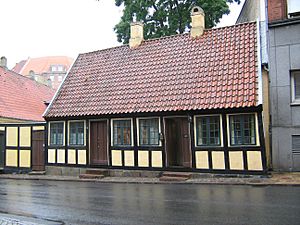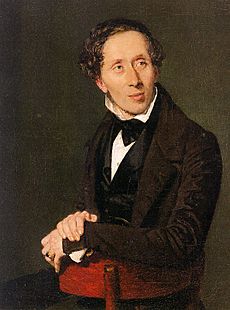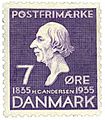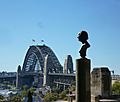Hans Christian Andersen facts for kids
Quick facts for kids
Hans Christian Andersen
|
|
|---|---|
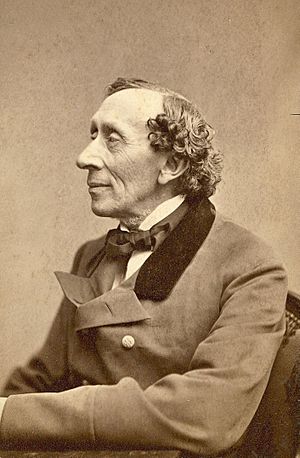 |
|
| Born | April 2, 1805 Odense, Denmark |
| Died | August 4, 1875 (aged 70) Copenhagen, Denmark |
| Occupation | Writer |
| Nationality | Danish |
| Genre | Romanticism Fairy tales |
Hans Christian Andersen (born April 2, 1805 – died August 4, 1875) was a famous Danish writer. He is best known for his wonderful fairy tales, which are loved by children and adults all over the world.
Andersen was born in Odense, Denmark. His family was very poor. His father was a shoemaker, and his mother worked as a washerwoman. When he was 11, his father passed away. At 14, Andersen decided to leave home and move to Copenhagen.
In Copenhagen, the king helped Andersen get a good education. Andersen first wanted to be an actor or a dancer. But he soon realized his true talent was writing. In 1835, he published his first collection of fairy tales. People really enjoyed them, and this encouraged him to write many more.
Andersen's stories became popular across Europe. He traveled a lot and met many important people. He was a thoughtful person who loved to explore new places. He passed away on August 4, 1875, after a period of illness.
Contents
Early Life and Education
"It doesn't matter about being born in a duckyard, as long as you are hatched from a swan's egg"
Hans Christian Andersen was born in Odense, Denmark, on April 2, 1805. He was an only child. His father, also named Hans, was a shoemaker who loved to read to his son. He introduced young Hans to exciting stories like Arabian Nights. Andersen's mother, Anne Marie Andersdatter, worked as a washerwoman and could not read or write.
After his father died in 1816, Andersen had to help support himself. He went to a local school for poor children. He also worked as an apprentice for a weaver and then a tailor. When he was 14, he moved to Copenhagen hoping to become an actor. He had a beautiful singing voice and was accepted into the Royal Danish Theatre. However, his voice soon changed. A friend at the theatre suggested that Andersen should try writing instead.
Jonas Collin, who was the director of the Royal Danish Theatre, saw Andersen's potential. He helped Andersen go to a grammar school in Slagelse. King Frederick VI even paid for part of Andersen's education. Andersen had already published his first story, "The Ghost at Palnatoke's Grave," in 1822. He also attended school in Elsinore until 1827.
Andersen later said that his school years were very difficult. He felt discouraged from writing by some of his teachers.
Writing Career
First Works
An early fairy tale by Andersen, called "The Tallow Candle" (Tællelyset), was found in Denmark in 2012. He wrote this story in the 1820s when he was still in school. It was about a candle that felt unappreciated.
In 1829, Andersen became quite successful with his short story "A Journey on Foot from Holmen's Canal to the East Point of Amager." After this, he wrote a play and a small book of poems. In 1833, the king gave him money to travel. This allowed Andersen to go on many trips across Europe. His travels in Italy inspired his first novel, The Improvisatore (Improvisatoren), which was published in 1835 and became very popular.
Famous Fairy Tales
Andersen's first attempts at writing fairy tales were often based on stories he had heard as a child. In 1835, he published the first parts of his famous Fairy Tales (Eventyr). More stories were added to complete the first book in 1837. This collection included nine tales, such as "The Tinderbox", "The Princess and the Pea", "Thumbelina", "The Little Mermaid", and "The Emperor's New Clothes". At first, these stories did not sell very well. At the same time, Andersen had more success with his novels, O.T. (1836) and Only a Fiddler (1837).
Andersen returned to writing fairy tales in 1838 with a new collection. This included "The Daisy", "The Steadfast Tin Soldier", and "The Wild Swans".
In 1845, Andersen's fairy tales became much more widely known. Four translations of his stories were published. "The Little Mermaid" appeared in a magazine, and other books like Wonderful Stories for Children were released. A review in a London magazine in 1846 praised Wonderful Stories, saying it was "a book full of life and fancy; a book for grandfathers no less than grandchildren."
Andersen continued to write and publish fairy tales in parts until 1872. Many of his stories were influenced by Christian beliefs, which were very important in Danish culture when he was growing up.
Here are some of his most famous fairy tales:
- The Princess and the Pea (1835)
- The Tinderbox (1835)
- Thumbelina (1835)
- The Little Mermaid (1837)
- The Emperor's New Clothes (1837)
- The Steadfast Tin Soldier (1838)
- The Swineherd (1841)
- The Ugly Duckling (1843)
- The Little Match Girl (1845)
- The Snow Queen (1845)
- The Fir Tree (1845)
- The Shadow (1847)
Images for kids
-
Carl Alexander (1818–1901), a German Duke whom Andersen knew
-
A Danish Postage stamp from 1935 featuring Andersen
-
A Postage stamp from Kazakhstan, 2005
-
A statue of Hans Christian Andersen in Sydney, Australia
See also
 In Spanish: Hans Christian Andersen para niños
In Spanish: Hans Christian Andersen para niños


